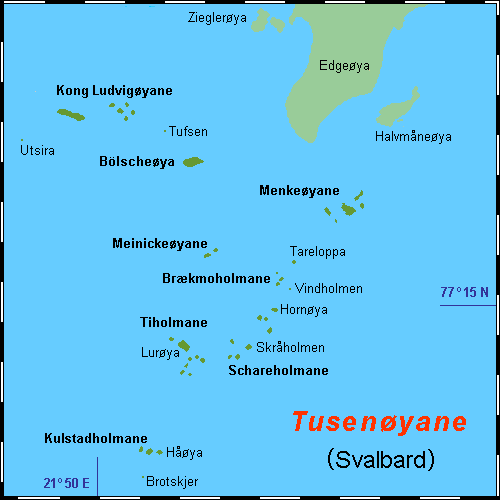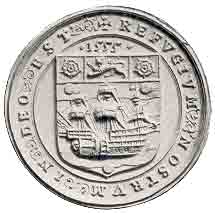|
Thousand Islands (Svalbard)
Thousand IslandsDodd, G. J., G. P. Benson, & D. T. Watts. 1996. ''Arctic Pilot'', vol. 2. Taunton, UK: Hydrographer of the Navy, p. 225. ( no, Tusenøyane) is a group of small islands south of Edgeøya. They form part of the Svalbard archipelago. The group consists of over forty islands and islets, including Brotskjer, Kulstadholmane, Utsira, Tufsen, Kong Ludvigøyane, Bölscheøya, Hornøya, Tiholmane, Meinickeøyane, Sletteøya, Schareholmane, Skråholmen, Brækmoholmane, Tareloppa, Vindholmen, and Menkeøyane. History The Dutchman Joris Carolus was the first to distinctly mark a group of small islands south of Edgeøya. The Muscovy Company's map (1625) showed a vague mass of islands as well, some labeled, such as ''Wester I.'', ''Beare Iland'', ''Heling I.'', and the ''Hopeless Iles.'' (perhaps Kong Ludvigøyane). The cartographers Gerard Valck and Peter Schenk the Elder were the first to place a "great vague mass of islands stretching round the coast" south of ... [...More Info...] [...Related Items...] OR: [Wikipedia] [Google] [Baidu] |
Schareholmane
Schareholmane ( en, Schare Islands or ''Schare Islets'') is a group of three larger and a few smaller islets east of Tiholmane, part of Thousand Islands, an archipelago south of Edgeøya Edgeøya (), occasionally anglicised as Edge Island, is a Norwegian island located in southeast of the Svalbard archipelago; with an area of , it is the third-largest island in this archipelago. An Arctic island, it forms part of the Søraust-Sva .... The group includes Blokkøya, Kvalbeinøya and Havmerra. The islets are named after Christian Schare, who, along with four others, was forced to overwinter here after they had lost their ship on September 3, 1833. All but one (who had died) were saved on June 22, 1834. References * Norwegian Polar InstitutPlace Names of Svalbard Database Islands of Svalbard {{svalbard-geo-stub ... [...More Info...] [...Related Items...] OR: [Wikipedia] [Google] [Baidu] |
William Scoresby
William Scoresby (5 October 178921 March 1857) was an English whaler, Arctic explorer, scientist and clergyman. Early years Scoresby was born in the village of Cropton near Pickering south-west of Whitby in Yorkshire. His father, William Scoresby (1760–1829), made a fortune in the Arctic whale fishery and was also the inventor of the barrel crow's nest. The son made his first voyage with his father at the age of eleven, but then returned to school, where he remained until 1803. After this he became his father's constant companion, and accompanied him as chief officer of the whaler ''Resolution'' when on 25 May 1806, he succeeded in reaching 81°30' N. lat. (19° E. long), for twenty-one years the highest northern latitude attained in the eastern hemisphere. During the following winter, Scoresby attended the natural philosophy and chemistry classes at Edinburgh University, and again in 1809. Scientist In his voyage of 1807, Scoresby began the study of the meteorology and ... [...More Info...] [...Related Items...] OR: [Wikipedia] [Google] [Baidu] |
Peter Schenk The Elder
Petrus Schenck, or Pieter, or Peter Schenk the Elder (baptized: 26 December 1660 – between 12 August and 17 November 1711 in Leipzig) was a German engraver and cartographer active in Amsterdam and Leipzig.Pieter Schenk (I) in the Life The engraver and map publisher Peter Schenk was born in 1660 in . He moved to Amsterdam in 1675 and became a student of specializing in |
Gerard Valck
Gerard Valck (30 September 1652 – 21 October 1726) was a Dutch engraver, publisher and cartographer. Biography Valck was born in Amsterdam on 30 September 1652 to an Amsterdam silversmith. He was a student of Abraham Blooteling and later married Blooteling's sister. He went to London with Blooteling in 1672 and may have remained there until 1680. Valck engraved many portraits of English nobility and worked frequently with Blooteling. His earliest dated mezzotint is titled ''Sleeping Cupid'' and was published in 1677. He based many of his engravings and mezzotints after designs by other artists like Peter Lely, Gérard de Lairesse and Philip Tideman. He published most of his works himself. In Amsterdam, he had a close partnership with his son Leonardus Valck and Peter Schenk the Elder Petrus Schenck, or Pieter, or Peter Schenk the Elder (baptized: 26 December 1660 – between 12 August and 17 November 1711 in Leipzig) was a German engraver and cartographer active in Amst ... [...More Info...] [...Related Items...] OR: [Wikipedia] [Google] [Baidu] |
Muscovy Company
The Muscovy Company (also called the Russia Company or the Muscovy Trading Company russian: Московская компания, Moskovskaya kompaniya) was an English trading company chartered in 1555. It was the first major chartered joint stock company, the precursor of the type of business that would soon flourish in England and finance its exploration of the world. The Muscovy Company had a monopoly on trade between England and Muscovy until 1698 and it survived as a trading company until the Russian Revolution of 1917. Since 1917 the company has operated as a charity, now working within Russia. Chancellor would function as the navigator of the small fleet, which consisted of three ships: the ''Bona Esperanza'' under Willoughby, the ''Edward Bonaventure'' under Chancellor and the ''Bona Confidentia''. The fleet departed from London on 10 May 1553, but near the Lofoten islands a storm hit the ships and separated Chancellor's vessel from the other two. Willoughby even ... [...More Info...] [...Related Items...] OR: [Wikipedia] [Google] [Baidu] |
Joris Carolus
Joris Carolus (–) was a Dutch cartographer and explorer who was employed by the Noordsche Compagnie and the Dutch East India Company. Career Carolus apparently was a native of Enkhuizen. After he lost a leg at the Siege of Ostend (1601–04) he turned to the art of navigation and became a pilot (''Stierman''). In 1614 he was pilot of the Enkhuizen ship ''den Orangienboom'' (“Orange Tree”), under Jacob de Gouwenaer, one of the two ships sent by the whaling company ''Noordsche Compagnie'' on a voyage of discovery. Carolus claimed to have reached 83° N, but this would have been impossible given the ice conditions described by Robert Fotherby, who was also on a voyage of discovery in the ship ''Thomasine'', sent by the rival Muscovy Company of England. According to Fotherby—who saw the Dutch ships riding off Amsterdam Island on July 6/16, "ready for the first opportunity to discover", and on August 9/19 "two ships of the Hollanders, that were appointed for northern discovery, w ... [...More Info...] [...Related Items...] OR: [Wikipedia] [Google] [Baidu] |
Menkeøyane
Menkeøyane ( en, Menke Islands) is a small Norwegian island group south of Halvmåneøya, an island off the southeast coast of Edgeøya. The group includes Havella, Alka, Gassen, Teisten, Islomen and Blåmåken. They comprise part of Thousand Islands. The islands are named after the German cartographer and historical geographer Heinrich Theodor Menke Heinrich Theodor Menke (24 May 1819 – 14 May 1892) was a German geographer, who was born and lived in Bremen. He is remembered for his work in historical geography. Menke studied theology and philology at the University of Bonn, and in 1842 rec ... (1819–92). The islands appear on the Muscovy Company's map (1625), one of which is labeled ''Heling I''. References * Norwegian Polar InstitutPlace Names of Svalbard Database*Purchas, S. 1625. Hakluytus Posthumus or Purchas His Pilgrimes: Contayning a History of the World in Sea Voyages and Lande Travells by Englishmen and others. Volumes XIII and XIV (Reprint 1906 J. Maclehose ... [...More Info...] [...Related Items...] OR: [Wikipedia] [Google] [Baidu] |
Vindholmen
Vindholmen ( en, "Wind Island" or "Wind Islet") is a small islet southeast of Brækmoholmane, part of Thousand Islands, an island group south of Edgeøya Edgeøya (), occasionally anglicised as Edge Island, is a Norwegian island located in southeast of the Svalbard archipelago; with an area of , it is the third-largest island in this archipelago. An Arctic island, it forms part of the Søraust-Sva .... References * Norwegian Polar InstitutPlace Names of Svalbard Database Islands of Svalbard {{svalbard-geo-stub ... [...More Info...] [...Related Items...] OR: [Wikipedia] [Google] [Baidu] |
Tareloppa
Tareloppa is an islet 2 miles (3 km) northeast of Brækmoholmane, part of Thousand Islands, an archipelago south of Edgeøya Edgeøya (), occasionally anglicised as Edge Island, is a Norwegian island located in southeast of the Svalbard archipelago; with an area of , it is the third-largest island in this archipelago. An Arctic island, it forms part of the Søraust-Sva .... References * Norwegian Polar InstitutPlace Names of Svalbard Database Islands of Svalbard {{svalbard-geo-stub ... [...More Info...] [...Related Items...] OR: [Wikipedia] [Google] [Baidu] |
Brækmoholmane
Brækmoholmane ( en, Brækmo Islands) is an island group composed of three islands, Store Brækmoholmen, Trønderen and Alkekongen. They form part of Thousand Islands, an archipelago south of Edgeøya. The islands are named after the Norwegian sailor and fisherman Sivert Brækmo (1853-1930), who visited Svalbard Svalbard ( , ), also known as Spitsbergen, or Spitzbergen, is a Norwegian archipelago in the Arctic Ocean. North of mainland Europe, it is about midway between the northern coast of Norway and the North Pole. The islands of the group range ... regularly between 1876 and 1895. References * Norwegian Polar InstitutPlace Names of Svalbard Database Islands of Svalbard {{DEFAULTSORT:Braekmoholmane ... [...More Info...] [...Related Items...] OR: [Wikipedia] [Google] [Baidu] |
Skråholmen
Skråholmen ( en, Sloping Island) is an islet about 2 miles (3 km) northeast of Schareholmane. It is part of Thousand Islands, an archipelago south of Edgeøya Edgeøya (), occasionally anglicised as Edge Island, is a Norwegian island located in southeast of the Svalbard archipelago; with an area of , it is the third-largest island in this archipelago. An Arctic island, it forms part of the Søraust-Sva .... References * Norwegian Polar InstitutPlace Names of Svalbard Database Islands of Svalbard {{svalbard-geo-stub ... [...More Info...] [...Related Items...] OR: [Wikipedia] [Google] [Baidu] |


